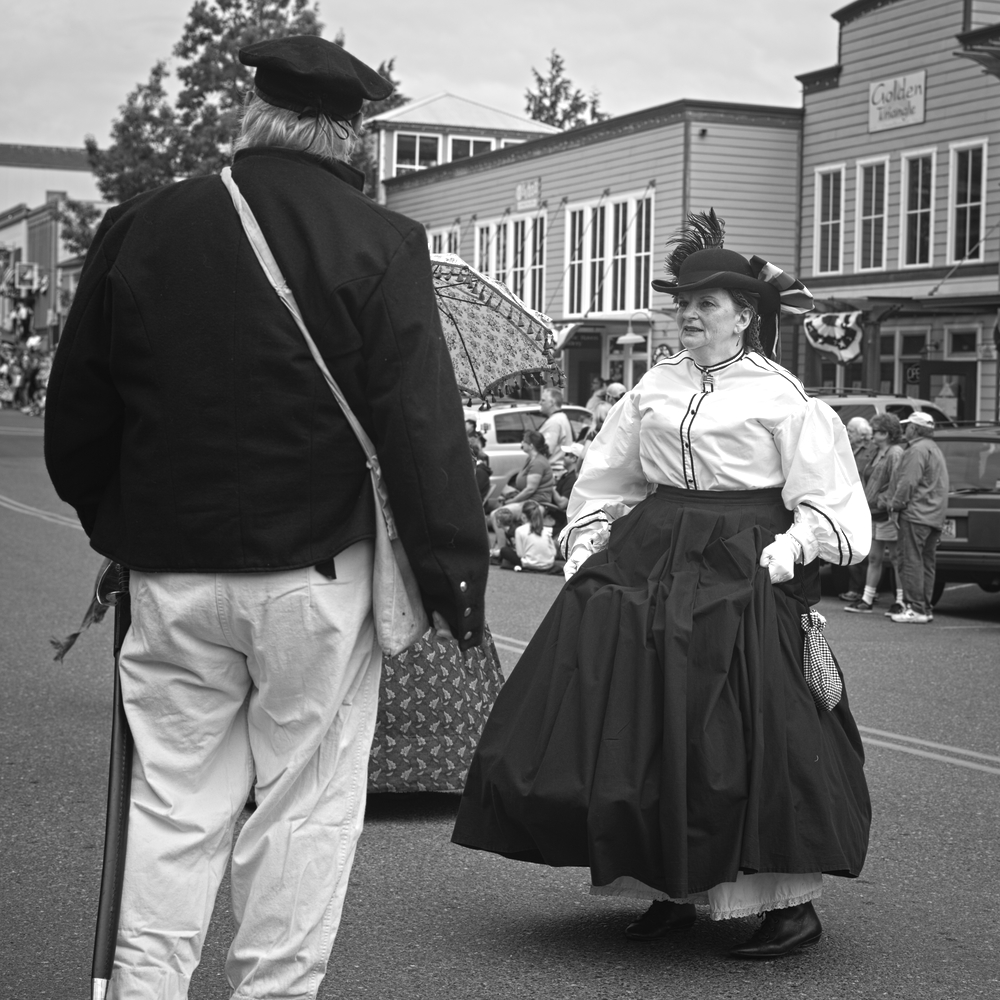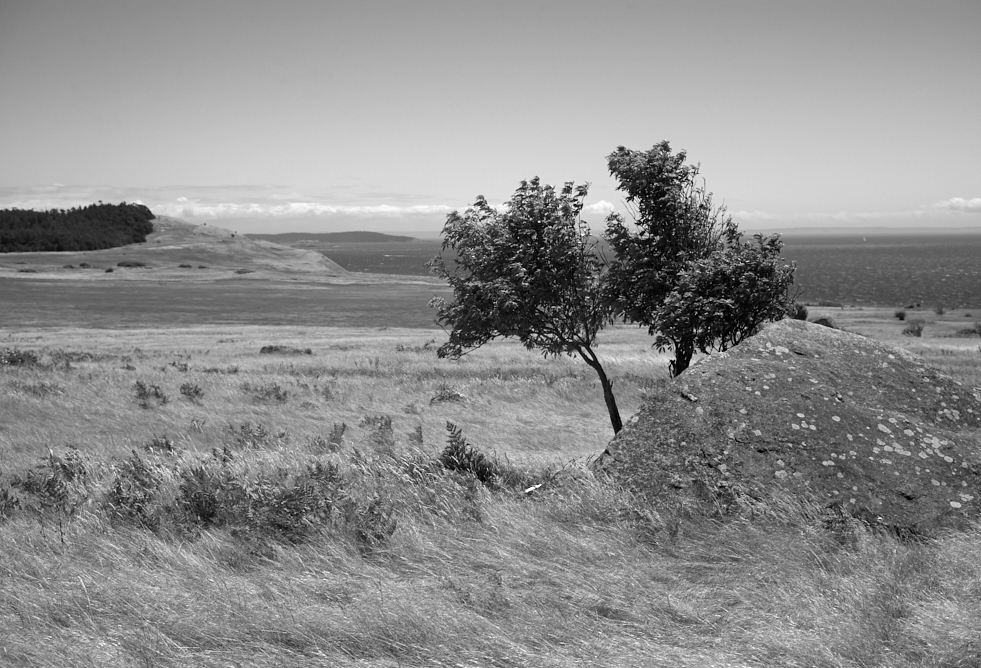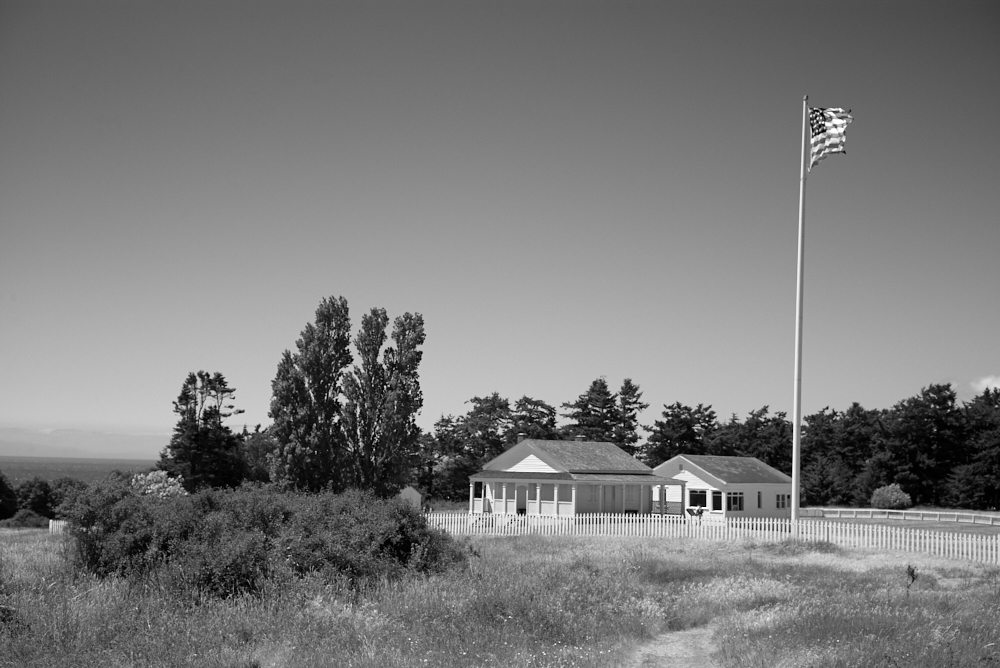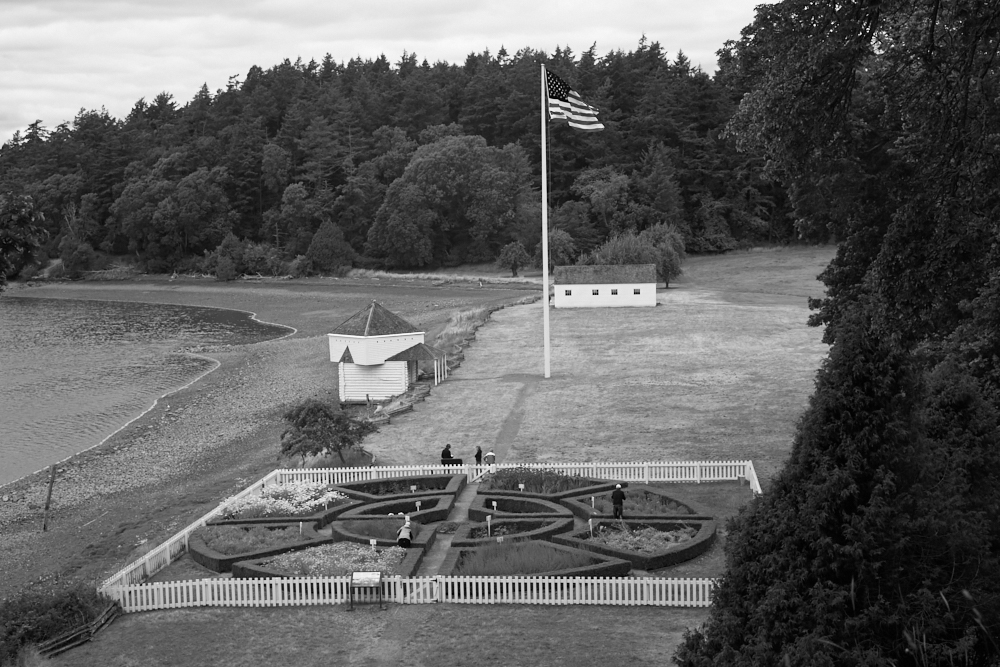The Salish Sojourn II
The Great Pig War of San Juan Island

Friday Harbor residents, dressed in period costumes at the Fourth of July Parade
San Juan Island narrows to a long peninsula at its southern end, a tail trailing in the turbulent waters of the Strait of Juan de Fuca. The trees do not extend to the end of the island, and for more than two miles, the wind blows unchecked over a prairie of golden, sun-bleached grass. 20,000 years ago, the island was buried beneath the Fraser Glacier, an ice sheet that was a mile deep. Today, the only signs of colder time are the rounded slopes of the peninsula, and the large erratics, blocks of stone that rest among the wind-lashed prairie grass.

An erratic, a large block of stone left behind after the Fraser Glacier receded
It was here, among the grasses and erratics, that the British Hudson's Bay Company, elected to begin an agricultural field station — the Belle Vue Sheep Farm — and nearly precipitated a war between two great powers.
The Great Pig War of 1853 is one of the most famous wars that never happened. In the middle of the nineteenth century, both Britain and the young United States were expanding their claims in the newly-explored West. After considerable wrangling, an equable division of the new frontier was hammered out in the Treaty of Oregon, which was signed in London in 1846. This treaty established a border between the United States and the British territory, that followed the 49th parallel line, from the Rocky Mountains to the middle of the channel that separated Vancouver Island and the mainland. At that point the border turned south, looped around the southern end of Vancouver Island, and proceeded out to sea, down the center line of the Strait of Juan de Fuca.
The signatories of the treaty had overlooked an important question: who owned the San Juan Islands, adrift in the no-man's land between the United States and British Vancouver Island? Did the new border split the island group, or leave them to one side or the other? The treaty was unclear on this point. Consequently, the Hudson's Bay Company, operating out of Vancouver Island, elected to take the initiative, and claimed San Juan Island for the British. To secure their claim, they established a sheep farm on the southern end of the island in 1853, seven miles across the Haro Strait from Vancouver Island. Fed by the ample prairie grass, the sheep fattened, reproduced, and soon more than 4,000 animals lived under British rule.

The windswept prairie near the old Belle Vue Farm
Although possession is commonly asserted to be 9/10 of the law, the appropriation of the land by the British did not automatically fold it into the empire. The Americans also claimed the island, and soon settlers began to arrive from the mainland. In 1859, 18 families staked claims on the island. Tension began to mount between the interlopers and the sheep ranchers; the Americans expected their government to support their claims to land, while the British regarded them as squatters, vermin who had illegally appropriated prime sheep grazing territory.
American farmer, Lyman Cutlar, precipitated a crisis when he shot a British pig that was rooting up his garden. The British threatened to arrest Cutlar and his compadres and throw the entire motley crew off the island. The settlers appealed for protection to General William Selby Harney, who was in command of the Department of Oregon. Harney was a long-serving military man with a checkered past: he had once beaten a female slave to death for misplacing his keys. Somewhat unusually for the time, this brutal act had stirred up public outrage, and Harney had been forced to flee Missouri, one step ahead of a murder charge. Although this sounds remarkably enlightened of the good people of Missouri, it must be sadly noted that after the furor had subsided, he returned to his town and was acquitted of murder.
He had spent most of his military career enforcing the United State's theft of land from the Native Americans, and by 1859, was the commander of American forces in the Oregon Territory. When word reached him that the British were threatening Americans, he was only too happy to intervene, sending 64 infantrymen north to offer protection and secure the island for America.
An arms race began: both sides augmented their forces in the face of imminent battle. The British deployed five warships carrying Royal Marines to the scene while the US forces established a camp on the southern end of the island where it could menace Belle Vue Sheep Farm. The Americans dug in for battle while the British fleet practiced maneuvers and shot their cannons at the cliffs of Griffin Bay.

The Officers Quarters, American Camp
Just south of the American Camp, a small hill offers a view of Haro Strait and the snow-capped Olympic Mountains, glistening in the sun across the Strait of Juan de Fuca. Here, in a place called Robert's Redoubt, the commander of the American forces, Lt. Colonel Silas Casey, had his men build stone-reinforced gunnery platforms. They then dragged eight cannons, capable of firing 32 pound balls, up the hill and pointed them seaward. From this commanding position, they could lob cannon balls down onto the British fleet, should it come to that.
When word of the crisis reached President Buchanan in Washington D.C., he elected to send one of his top troubleshooters, General Winfield Scott, to the region. Scott, whose nickname was "Old Fuss and Feathers," remains America's longest serving general — forty-seven years in that position. Known for his immense girth, as well as his diplomatic acumen, he was forced to take a ship from the East, crossing overland at Panama, and after a six week passage, arrived on the scene of the brewing battle. Scott appears to have been unimpressed by the actions of Harney, questioning the intelligence of an officer who would start a war over a dead pig. A skilled negotiator, he engineered a face-saving truce. Both sides would reduce their forces, withdraw to opposite ends of the island, and establish two camps until a permanent solution could be hammered out between the governments. The British created the "English Camp" on Garrison Bay in the north, while the Americans remained in their camp near Griffin Bay.
This detente lasted for twelve years, and was finally resolved when the two powers signed the Treaty of Washington. The question of ownership of the San Juan Islands was referred for mediation to Kaiser Wilhelm I of Germany, who ultimately ruled in favor of the Americans. The islands passed into American hands, and the great war over a pig was averted through a triumph of diplomacy.
Today, only three buildings remain of the American Camp: two buildings that served as officer's quarters sit within a field surrounded by a white picket fence, while a third building, the residence of the laundress, stands outside the fence to the west. Prior to 2010, there were only two original buildings on the site; after the cessation of "hostilities," the camps were closed and their buildings were auctioned off and moved. In December 2010, a home in Friday Harbor, the Adam Brown house, was identified as one of the missing buildings from the camp, and it was relocated to the site.
It is a pleasant location, on a sunny day when the wind is calm, but I wonder how often that would have been the case. We are buffeted by a very strong breeze, that lay the grass flat and snapped the large American flag that stands within the confines of the camp. The location was undoubtedly chosen for its strategic value; comfort was certainly not an issue

A white picket fence marks the boundary of the American Camp
The location of the British Camp reflected the sensibility of its first inhabitants. It is placed on the lunate shore of Garrison Bay, a peaceful spot ringed with old growth cedar, spruce, and madrone trees. The descent down a single lane road is a marvel, winding through a thick, interlaced grove of gnarled trees. Once again, it strikes me as an underexploited resource: no more than six cars are parked in the lot when we arrive, and a great silence hangs over the park.

The British camp with formal English garden
As with the American Camp, most of the original buildings are gone. The British terraced their camp into three major levels: the primary camp buildings, including the enlisted quarters, were on the lowest level in a great meadow just above the highwater mark. Next, set back from the camp, up a hill, was officer country. This offered a view of camp and bay, one step closer to the heavens for men of superior rank. And finally, occupying the summit of Olympus, looking down on both the officers and the enlisted men, was the commandant's house. Today the house is gone and the site is demarcated by a small stone obelisk and an informational placard. With its commanding view of the camp, it would have been the place to reside.

Obelisk marking the site of the commandant's quarters
The four extant buildings are all found on the lowest level. The largest was the barracks of the Royal Marines, a long structure that today serves as the visitors' center. A storehouse is found on the north end of the site, with a small building set back from the water that served as the infirmary. Common ailments of the day included broken bones, hernias, contusions, and syphilis, which were all treated in this building.

Infirmary, English Camp
The final structure, perched above the water's edge, is a blockhouse made of rough-sawn logs. This structure was based on an American design. It looks very odd, as if it had been cut in two, halfway up its height, and then the upper half had been rotated 45 degrees. The purpose of this odd configuration was to provide 360 degrees of fire for the riflemen who would occupy the structure during an attack by the Americans. A traditional, four-walled tower has blind spots; by rotating the upper half, riflemen could cover all of the approaches.

Octagonal Blockhouse
The attack never came. In fact, as time passed, the soldiers became very friendly, and spent a considerable amount of time exchanging visits, celebrating holidays together, and toasting both King and President with vast amounts of alcohol. When the truce ended and the island was ceded to the United States, both camps were abandoned, the buildings sold to civilians. Swords were beaten into plowshares, as this tense encounter, defused by diplomacy, came to an end.
In the final accounting, the only casualty, was a runaway porker.
If you are enjoying this series, why not subscribe to Richard's monthly newsletter, What's New in Old News? The Peripatetic Historian is on the road, roaming the world and compiling fresh adventures. Don't miss out. Click here to join the legions of above-average readers who have already subscribed.